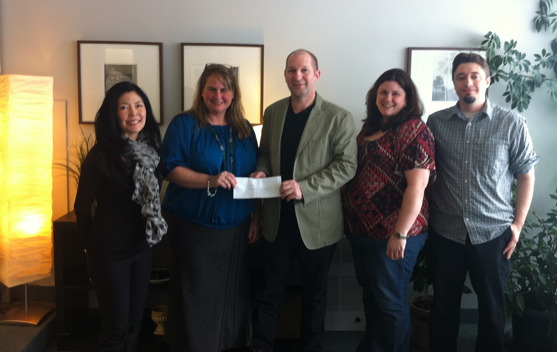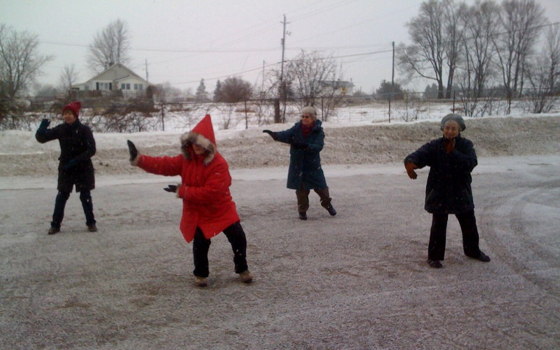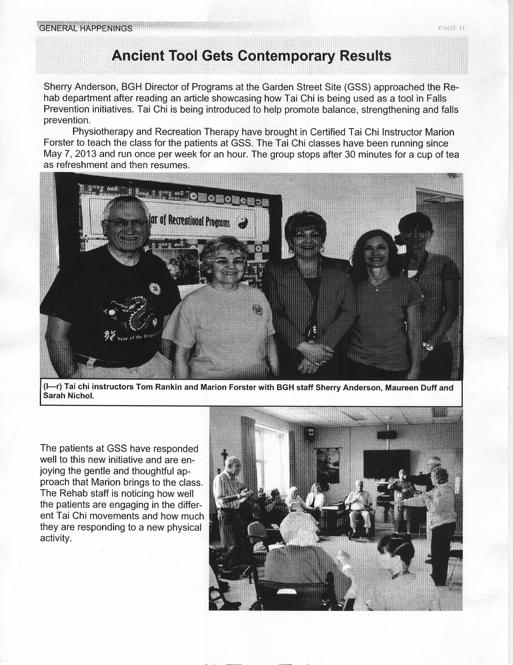

Information, News, and Events
Posted October 25, 2014

Posted August 17, 2014 Most interesting were the references to Liang's Three Treasures, which appear to be standing meditation, dan yu and tor yu! I recommend you read the article. It's fun and eye opening. I had heard rumours that Liang used dan yu and tor yu or exercises like them. This adds further credence to that theory. I have culled a few sentences from the article:

Posted June 23, 2014 First the quiz on the 5 basic principles of Master Moy's tai chi. Didn't take long to get them going, - front knee 90° to the ground (no, it's not knee over the toe everyone), 45° angle of the back foot, straight line from the heel to the head, hips square to the front, and equal and opposite forces with the arms. Then an exploration of the simplified Tor Yu that Master Moy taught, - go back turn the trunk of the body, turning open to 45° at the back, hands crossed at the wrist (away from the body), then push down slightly with the hands and turn the hips to the front while the hands "smooth the tablecloth", ending shoulder width apart. Now just push out the arms, ending at shoulder level. And then that Tor Yu demo by 88 year old Joan, showing how the entire back stretches out when done properly. Definitely an awesome example for us all. Finally we looked at sequencing of movement through a tai chi posture, - stand up, sit, step, then (and only then) move the arms. We tried it in Brush Knee, Repulse Monkey and Parting Wild Horse's Mane. I knew the day was truly a success when after lunch one of the members leaving the restaurant, as they went out of sight was repeating, "stand up, sit, step, move the arms". Thanks to the Sunshine Coast tai chiers for a great workshop and a fun day. Here is a link to a video by Gill Hedley who gives a lesson on the importance of movement and stretching to maintain the sliding properties of tissues in the body. Thanks to Dave Pinto (a tai chi instructor and health practitioner in Toronto) for providing this link. Doug Overholt 
Posted April 27, 2014 The Fuzz Speech 
Posted March 31, 2014
In summary, Mr. Moy would count three:
Finally the toryu should not feel constrained or twisted. Take your time. Don't try to sit too low. 
Posted February 28, 2014 The CTCA Kanata Tai Chi group began in January 2013, with 2 more beginner classes since then being offered to the community, the most recent being February 2014. There are around 30 members whose hard work, persistence and patience have benefitted from the Tai Chi exercise, along with regular meals out which have helped form a great spirit of fun and friendship among the students. Two local groups who have benefitted from the members generosity are the Restoring Hope Mission, who are a non-profit group that provides a bed for the homeless one night a week in Ottawa. Most recently is the David Smith Youth Treatment Centre, another not for profit organisation who provide a comprehensive treatment programme for young adults and their families affected by substance abuse and mental illness. The welcome tea break during the class has resulted in "tea money" donated by members going to these local groups, with $100 collected earlier in the year for the Restoring Hope Mission and $200 collected for the DSYTC.  Pictured accepting the Canadian Tai Chi Academy Kanata donation on behalf of the DSYTC, Ottawa, is Stephanie Macgregor Executive Director. Along with Sherri Nettleton (CTCA President), Darren Pryke (CTCA Instructor), and Natasha Hanley & Owen Marks (both Assertive Continuing Care Councillors for the DSYTC). 
Posted February 27, 2014  Members of the Canadian Tai Chi Academy will practice in any weather. From left Dorothy Maxim, Eleanor Beelich, Diane Hyndman and Marian Forster who are practicing outside Montague Centennial Hall Friday, January 17th. At the time the picture was taken, it was -17 degrees C. and windy. When the paper arrived in the Thursday mail on January 22, it was -25 to -30 C. People really noticed this photo and found it both admirable and funny. What readers did not know was that we had taken to the outdoors due to a problem with the heating system in the Hall. 
Posted February 26, 2014 Could I? Would I? Had to think about this. Montague, Ontario is a remote location. How did they get my name? Brockville is 45 minutes drive from here. When could I fit this in? Well, back in the day, I had assisted in Classes which we in The Academy would now call Sitting Form Classes and had attended various Sitting Form Workshops. And I had been teaching Tai Chi for sixteen years. A Recreation Therapist from the Brockville General, actually lives not far from here. She had picked up our brochure at the local coffee shop one Saturday morning. LEAVE YOUR INFORMATION AROUND. YOU NEVER KNOW WHAT WILL HAPPEN. We talked. She visited a Montague class. The Director of Programs at the Hospital had asked her to "find someone". A respected journal had recommended Tai Chi as the only - ONLY - exercise that truly improves core strength and balance. I couldn't say no. We started in April, 2013. The following article appeared in the Brockville Hospital Newsletter during our third visit:  My Tai Chi life has now totally changed. More Blog to follow after this one. This story is a serial. Stay tuned! Marian Forster 
Posted January 24, 2014 Danyu and Toryu Danyu and toryu train the principles of our tai chi. They are not just warm up exercises. See them in everything you do in tai chi. Sit low, but not too low, because then you cannot turn the spine. Too high, no power. There is an optimal level of sit where you can turn efficiently. The power is in the legs, in the waist and in the turning of the spine. The action is like a spring, sit doesn't have to be low to be effective (leopard training). It should be effortless to push out [in the toryu]. If trouble pushing after sitting, that sit is incorrect, sit propels the push forward, do each one like the first one. On Doing Tai Chi Understand the principles and relate to sensations. Understand the principles as well as the form. We are changing our bodies, - our bone structure, circulation, tendons. Opening of each joint, the blood can go to another area, open up all those little joints. Sweating is very important. It opens up the pores, more pathways for circulation. At more advanced levels, the bones change. This is the meaning of changing the tendons. We need to make these changes in order to meditate for longer periods, you almost adhere to the ground effortlessly. We have "low clouds" limiting our bodies. Tai chi will push away the clouds to penetrate ? Internal Training
|

Posts Current 2023 2022 2021 2020 2019 2018 2017 2016 2015 2014 2013 |